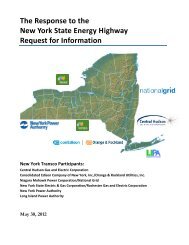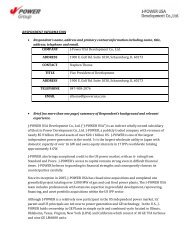Deepwater Wind - Energy Highway
Deepwater Wind - Energy Highway
Deepwater Wind - Energy Highway
Create successful ePaper yourself
Turn your PDF publications into a flip-book with our unique Google optimized e-Paper software.
!<br />
VI. Interconnection<br />
!<br />
<strong>Deepwater</strong> has developed a comprehensive interconnection plan that is based on a front<br />
end engineering design (FEED) study that it commissioned from SGC Engineering. The<br />
interconnection plan will be finalized through detailed engineering and design work in<br />
consultation with LIPA, NYISO, and ISO-NE.<br />
Shoreham 138 kV<br />
Power from the <strong>Wind</strong> Plant, as well as exports from ISO-NE, will be delivered to LIPA at<br />
the existing 138 kV substation at the Shoreham former nuclear power plant site.<br />
<strong>Deepwater</strong> commissioned Siemens PTI to prepare a preliminary interconnection<br />
feasibility assessment. This study found that there were few upgrades necessary on<br />
LIPA’s bulk transmission system needed to support the injection of power from<br />
<strong>Deepwater</strong>’s Project. <strong>Deepwater</strong> has also evaluated the Port Jefferson, Riverhead, and<br />
Buell substations as alternative points of interconnection in Zone K. Interconnecting at<br />
Shoreham increases the efficiency of the LIPA transmission system by supplying the<br />
under-served eastern load pocket and by more fully utilizing the transmission<br />
infrastructure that is currently in place.<br />
Brayton Point 345 kV<br />
In New England, the Project will interconnect at the Brayton Point 345 kV substation.<br />
During periods of low wind energy production, power may be exported from the Brayton<br />
Point interconnection to balance the output of the <strong>Wind</strong> Plant. During periods of high<br />
wind energy production, when the <strong>Wind</strong> Plant’s output exceeds 600 MW the excess<br />
power that cannot be delivered to LIPA will be diverted to ISO-NE and injected at<br />
Brayton Point. Accordingly, the Brayton Point interconnection has been designed for<br />
both injections and withdrawals. Siemens PTI has confirmed that the high-voltage 345<br />
kV system at Brayton Point is able to accept both injections and withdrawals. As an<br />
alternative to Brayton Point, <strong>Deepwater</strong> is also evaluating National Grid’s Kent County<br />
345 kV substation.<br />
Offshore HVDC<br />
The <strong>Wind</strong> Plant will be connected to an HVDC transmission system at the offshore<br />
converter station, delivering power to the AC bus before conversion to DC power.<br />
Deliverability and Interconnection Service<br />
<strong>Deepwater</strong> has commissioned a series of studies which suggest that the proposed 600<br />
MW can be delivered to the Shoreham 138 kV substation. Specifically, a FEED study<br />
performed by SGC Engineering established the optimal project configuration from the<br />
perspective of cost and functionality. In addition, <strong>Deepwater</strong> had Siemens PTI prepare a<br />
!<br />
19














